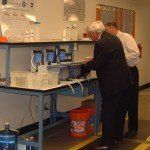Tips & Tricks
Aluminum Anodizing Tips for success!
Many of the people who happen onto one of our websites looking for anodizing or plating equipment

Aluminum Anodizing – Rinsing Tips Rinsing with DI (Deionized) Water
How Important IS Quality Rinsing? … VERY!!
Tap or industrial water has contaminants – usually calcium, sodium and magnesium. These are salts which can cause spots on the surface of cleaned parts and these spots can interfere with aluminum anodizing quality.
Rinse water baths of less than 200 ppm (Parts Per Million) of TDS (Total Dissolved Solids) are preferred. DI water by definition has little or no TDS. However, remember that every time you rinse parts, the rinse tank becomes more and more contaminated as you drag water in from the previous tank. So, monitor the rinse tank and replace the water as frequently as needed with fresh DI. A TDS meter is helpful to determine when it is time to change the water in the rinse tanks.
Aluminum Anodizing – Other Rinse Ideas
Air Agitation – Using air bubbles will help “scrub” the parts and free trapped contaminants in tight places like threads and blind holes. It also replaces oxygen in the rinses and the electrolyte which can be lost due to electrolysis. Oxygen is a necessary element in producing the aluminum oxide film. One final note, do not use compressed air as this can carry oils and other contaminants into the rinse tank. Use a low-pressure / high-volume air blower with a properly designed sparger (diffuser) to do the job right.
Double Rinse – It may sound obvious but taking the parts completely out of the rinse tank and then putting the parts back into the tank (double rinsing) helps remove surface contaminates and trapped gases in tight places.
Fog / Spray Rinse – Using a DI fog or spray gun can really help clean out parts in difficult places. We prefer the micro-fine nozzles that produce very little over-spray but impacts the parts with a lot of force. Fog guns let you get up close and personal with each part. It breaks the surface tension of the part, allowing the process chemistry to drop back into the process tank with a minimal amount of water added.
Hot water DI Rinse – If you are going to be anodizing a lot of parts, installing a hot water DI rinse will make life a lot easier. When heated between 1400 and 1800F, a DI Hot Rinse quick-dries your parts with no spotting, which will reduce or remove the need to blow-down or dry the parts in a dryer/oven. Caution… if you install an electric immersion heater in a plastic tank, make sure that it is approved for this application. You will also need to install over-temperature and low-level safety sensors and controls. Misapplication of an immersion heater can cause fires or severe shocks!
Blow Down– Try blowing down parts after a warm or hot final rinse to help prevent spotting. See an example here:
Summary:
Rinsing is a very important part of quality aluminum anodizing and should not be ignored.
How to Anodize Aluminum
